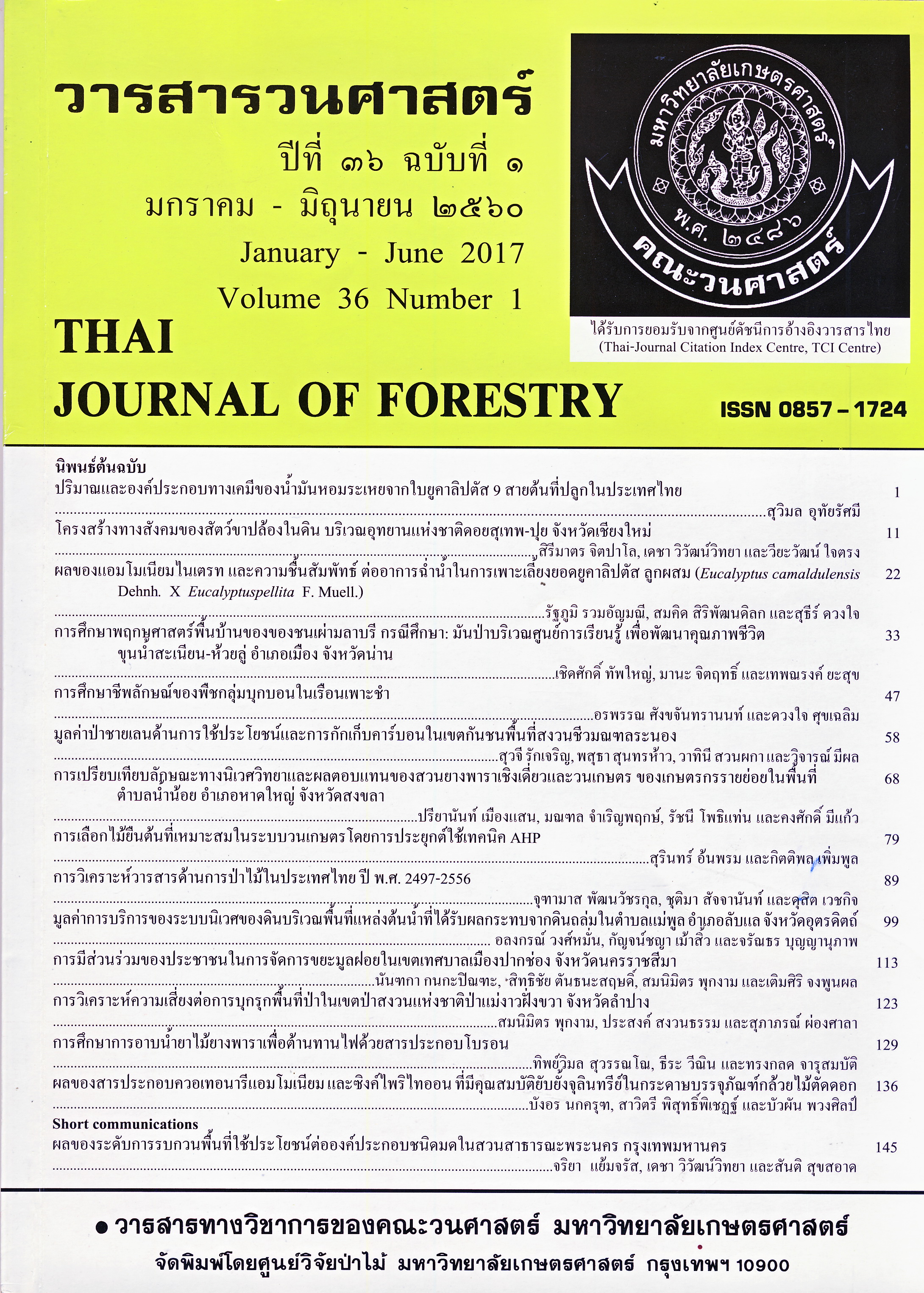การเลือกไม้ยืนต้นที่เหมาะสมในระบบวนเกษตรโดยการประยุกต์ใช้เทคนิค AHP
Main Article Content
บทคัดย่อ
วนเกษตรเป็นรูปแบบการใช้ประโยชน์ที่ดินที่ประกอบด้วยองค์ประกอบอย่างน้อย 2 อย่างโดยในองค์ประกอบนั้นต้องมีไม้ยืนต้นหรือพืชอายุยาวเป็นองค์ประกอบหลัก ด้วยคุณลักษณะดังกล่าวจึงทำให้ระบบวนเกษตรสามารถให้ผลผลิตได้มากกว่าหนึ่งอย่างทั้งทางเศรษฐกิจและสิ่งแวดล้อมอย่างไรก็ตาม การตัดสินใจเลือกองค์ประกอบในระบบวนเกษตรเป็นกระบวนการที่ค่อนข้างซับซ้อน มีปัจจัยที่เกี่ยวข้องหลากหลาย จึงต้องอาศัยเทคนิคที่เหมาะสมในการวินิจฉัยเพื่อเปรียบเทียบปัจจัยต่างๆ อันนำไปสู่การตัดสินใจเลือกองค์ประกอบที่มีความสำคัญสูงและเหมาะสมกับเงื่อนไขของเกษตรกร โดยทำการศึกษาในหมู่บ้านทุ่งฆ้อน ตำบลอวน อำเภอปัว จังหวัดน่าน มีประชากรทั้งสิ้น 134 ครัวเรือน และทำการสุ่มตัวอย่างครัวเรือนสำหรับการสัมภาษณ์ทั้งสิ้น 103 ครัวเรือน
งานวิจัยนี้มีวัตถุประสงค์เพื่อตัดสินใจเลือกไม้ยืนต้นที่เหมาะสมในระบบวนเกษตรบนพื้นที่สูง ผู้วิจัยได้นำกระบวนการลำดับชั้นเชิงวิเคราะห์ (Analytical Hierarchy Process: AHP) มาประยุกต์ใช้ในการวิเคราะห์คัดเลือกไม้ยืนต้นที่เหมาะสม ผลการศึกษา พบว่า กลุ่มตัวอย่างมากกว่าครึ่ง (58.3%) มีความสนใจที่จะปลูกไม้ยืนต้นร่วมกับข้าวโพดเลี้ยงสัตว์ในรูปแบบวนเกษตร ทางด้านปัจจัยเงื่อนไขสำหรับการตัดสินใจของเกษตรกรมีทั้งหมด 8 ปัจจัย ซึ่งปัจจัยที่มีความสำคัญ 3 อันดับแรก ได้แก่ การมีตลาดรองรับผลผลิตมีค่าน้ำหนักความสำคัญ 0.269 ความมั่นคงในการเป็นเจ้าของที่ดิน และความพร้อมด้านเงินลงทุน มีค่าน้ำหนักความสำคัญ 0.243 ตามลำดับ ผลการวิเคราะห์เพื่อหาไม้ยืนต้นที่เหมาะสมในระบบวนเกษตร พบว่า ไม้ยืนต้นที่เหมาะสมอันดับที่หนึ่ง คือยางพารามีผลการประเมินอยู่ที่ระดับ 44.8% สูงกว่า สัก ซึ่งมีผลการประเมินอยู่ที่ 31.7% และเงาะ ซึ่งมีผลการประเมินอยู่ที่ 23.5%
Downloads
Article Details
ข้าพเจ้าและผู้เขียนร่วม (ถ้ามี) ขอรับรองว่า ต้นฉบับที่เสนอมานี้ยังไม่เคยได้รับการตีพิมพ์และไม่ได้อยู่ในระหว่างกระบวนการพิจารณาตีพิมพ์ลงในวารสารหรือสิ่งตีพิมพ์อื่นใด ข้าพเจ้าและผู้เขียนร่วม (ถ้ามี) ยอมรับหลักเกณฑ์และเงื่อนไขการพิจารณาต้นฉบับ ทั้งยินยอมให้กองบรรณาธิการมีสิทธิ์พิจารณาและตรวจแก้ต้นฉบับได้ตามที่เห็นสมควร พร้อมนี้ขอมอบลิขสิทธิ์ผลงานที่ได้รับการตีพิมพ์ให้แก่วารสารวนศาสตร์ คณะวนศาสตร์ มหาวิทยาลัยเกษตรศาสตร์ กรณีมีการฟ้องร้องเรื่องการละเมิดลิขสิทธิ์เกี่ยวกับภาพ กราฟ ข้อความส่วนใดส่วนหนึ่ง หรือ ข้อคิดเห็นที่ปรากฏในผลงาน ให้เป็นความรับผิดชอบของข้าพเจ้าและผู้เขียนร่วม (ถ้ามี) แต่เพียงฝ่ายเดียว และหากข้าพเจ้าและผู้เขียนร่วม (ถ้ามี) ประสงค์ถอนบทความในระหว่างกระบวนการพิจารณาของทางวารสาร ข้าพเจ้าและผู้เขียนร่วม (ถ้ามี) ยินดีรับผิดชอบค่าใช้จ่ายทั้งหมดที่เกิดขึ้นในกระบวนการพิจารณาบทความนั้น”
เอกสารอ้างอิง
วิทยา อินทร์สอน และ สุรพงศ ์บางพาน. 2557. แนวทางการพัฒนาใช้กระบวนการวิเคราะห์เชิงลำดับชั้นในงานอุตสาหกรรม. Industrial Technology Review 20 (256): 129-135.
วิฑูรย์ ตันศิริคงคล. 2542. AHP กระบวนการตัดสินใจที่ได้รับความนิยมมากที่สุดในโลก. พิมพ์ ครั้งที่ 1. กราฟฟิคแอนด์ปริ้นติ้ง เซนเตอร์, กรุงเทพฯ.
วิฑูรย์ ตันศิริคงคล. 2557. AHP การตัดสินใจขั้นสูง เพื่อความก้าวหน้าขององค์กรและความอยู่ดีมีสุขของมหาชน. พิมพ์ครั้งที่ 1. บริษัท อมรินทร์พริ้นติ้งแอนด์พับลิชชิ่ง จำกัด (มหาชน), กรุงเทพฯ.
วิพักตร์ จินตนา. 2550. ระบบวนเกษตรและการจัดการ. ภาควิชาการจัดการป่าไม้ คณะวนศาสตร์ มหาวิทยาลัยเกษตรศาสตร์. กรุงเทพฯ.
สาวิตร มีจุ้ยและพิชัย สุรพรไพบูลย์ .2551. รายงานวิจัยฉบับสมบูรณ์ โครงการการพัฒนาทางเลือกระบบวนเกษตรที่เหมาะสมเพื่อทดแทนการปลูกข้าวโพดบนพื้นที่ลาดชันโดยเกษตรกรมีส่วนร่วม. เครือข่ายวิจัยเพื่อการพัฒนาเชิงพื้นที่ภาคเหนือตอนบน สำนักงานกองทุน สนับสนุนการวิจัย.
สำนักงานเศรษฐกิจการเกษตร. 2557. สถิติการเกษตรของประเทศไทยปี 2556. สำนักงานเศรษฐกิจการเกษตร กระทรวงเกษตรและสหกรณ์. กรุงเทพฯ.
องค์การบริหารส่วนตำบลอวน. 2556. แผนพัฒนาสามปี. องค์การบริหารส่วนตำบลอวน อำเภอปัว. น่าน.
Glover, E.K., H.B. Ahmed and M.K. Glover. 2013. Analysis of Socio-Economic Conditions Influencing Adoption of Agroforestry Practices. International Journal of Agriculture and Forestry 3 (4): 178-184.
Krejcie, R.V. and D.W. Morgan. 1970. Determining Sample Size for Research Activities. Education and Psychological Measurement 30 (3): 607-610.
Qureshi, M.E. 2003. Application of the Analytic Hierarchy Process to Riparian Revegetation Policy Options. Small-scale Forest Economics, Management and Policy 2 (3): 441-458.


